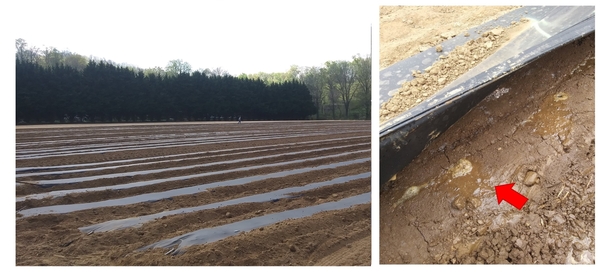Authors
Andres D. Sanabria-Velazquez1, Tika Adhikari1 and Frank Louws1,2
1Department of Entomology and Plant Pathology, North Carolina State University, 1575 Varsity Drive, VRB Module 6, Raleigh, NC 27695
E-mail: adsanabr@ncsu.edu ↲ and tbadhika@ncsu.edu ↲
2Department of Horticultural Science, North Carolina State University, 118 Kilgore Hall Raleigh, NC, 27695-7609.
E-mail: fjlouws@ncsu.edu ↲
Anaerobic Soil Disinfestation to Advance Tomato Plant Health
The phaseout of methyl-bromide left many agricultural systems vulnerable to soilborne diseases and pests. Regional Pest Management Strategic Plans, grower association priorities, and extension/research-based interactions with growers and industry partners identified major gaps in the efficacious management of tomato diseases (Verticillium wilt, Bacterial wilt, and root-knot nematodes). Addressing these threats requires integrated, multifaceted, and systems-based approaches. Recent soil treatment experiments in NC pursue the development of integrated and biologically based systems compared to standard or optimized fumigation systems that can restore “tired soils” and reduce high pathogen inoculum pressure by researching how grower inputs, plant genetics, and microbiomes are interconnected. We seek to explore the usefulness of Anaerobic Soil Disinfestation (ASD) in current production systems to suppress soilborne pathogens (and weeds) and enhance carbon inputs in soils and yields.
Researchers discovered ASD, also known as ‘Biological Soil Disinfestation (BSD)’, a systems-based approach for managing several soil-borne pathogens, plant-parasitic nematodes, and weeds in vegetable and fruit crops. This approach consists of incorporating carbon sources in the soil profile, followed by saturating the soil with water to induce anaerobic conditions. These soil conditions induce changes in the physicochemical and biological properties of the soil, favoring the rapid colonization of beneficial microbiomes and reducing pathogen populations. This technique is a very promising method, as it has been shown in previous works to have an efficacy comparable to chemical fumigants, with the advantage that it can be used in both organic and conventional crop production systems. This is a soil ‘amendment approach’, not a fumigant alternative.
The effectiveness of ASD mainly depends on the selection of carbon sources, the amount of carbon applied to the beds, and the length of time the soil is in an anaerobic state. Additionally, soil temperature and soil water content are equally important. Labile organic byproducts can be used as carbon sources for ASD. Carbon sources that initiate ASD in different production systems include agricultural by-products such as ethanol, molasses, rice bran, mustard meal, wheat bran, compost, heat-treated poultry litter, crucifer cover crops, and legume cover crops.
1-Soil preparation and amendment
The grower prepares the soil in advance (disced, pre-plant fertilizer, pH adjusted). Beds are pre-formed, and the carbon sources are placed on top of the pre-formed beds at high rates of approximately 9 tons per acre. Carbon sources are rototilled into the bed to ensure thorough mixing approximately 8 inches deep (Figure 1).
The seasonality of carbon (e.g., “waste products”) availability affects the prices. Therefore, this should be considered before choosing a carbon source. Carbon sources that break down quickly and have a carbon-to-nitrogen ratio of 10:1 to 35:1 can be used for ASD.
2-Soil saturation and coverture with plastic mulch
To saturate the soil with water, growers can use standard practices, i.e., a lay-flat tubing is rolled out, and a ½-inch non-perforated hose is fed to each ASD bed to saturate the ASD beds by splicing into the buried drip tape and capping the ends of the ASD area. Saturation with water will depend on the soil type, number of drip lines, and drip line flow rates. Therefore, the time needed varies from 6 to 48 hours. Together with saturation with water, soil coverture with plastic mulch is necessary to prevent oxygen from entering the soil and limit the escape of gasses produced during ASD. Different types of plastic coverture can be used. Still, the totally impermeable film (TIF) will likely reduce the interchange of gases with the environment (depending on the diffusion coefficient of the various gases). Therefore, holes and plastic ripping should be avoided to achieve good anaerobic conditions (Figure 2).
3-Tarping period and post-treatment management
The tarping period varies from 3 weeks to 6 weeks, depending on the carbon source, soil type, and soil temperature. Higher temperatures favor ASD since soil microbes break down the carbon sources faster. Temperatures higher than 86°F are recommended to conduct ASD effectively. After the ASD period, it is recommended to puncture holes in the plastic at least 4-7 days before planting so phytotoxic compounds/gasses can dissipate. After aeration, the tomato transplants can be planted in the same holes and managed using growers’ standard practices (Figure 3).
Further reading
Momma, N., Kobara, Y., Uematsu, S., Kita, N., and Shinmura, A. 2013. Development of biological soil disinfestations in Japan. Appl. Microbiol. Biotechnol. 97:3801-3809.
Sanabria-Velazquez, A.D., Enciso-Maldonado, G.A., Maidana-Ojeda, M., Diaz-Najera, J.F., Ayvar-Serna, S., Thiessen, L.D. and Shew, H.D., 2023. Integrated Pathogen Management in Stevia Using Anaerobic Soil Disinfestation Combined with Different Fungicide Programs in USA, Mexico, and Paraguay. Agronomy, 13(5), p.1358.
Publication date: Feb. 7, 2024
Reviewed/Revised: Feb. 7, 2024
There is an alternate Spanish language version of this document here: Desinfestación anaeróbica del suelo para el manejo de enfermedades transmitidas por el suelo en la producción de tomate
N.C. Cooperative Extension prohibits discrimination and harassment regardless of age, color, disability, family and marital status, gender identity, national origin, political beliefs, race, religion, sex (including pregnancy), sexual orientation and veteran status.



